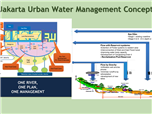Jakarta, Indonesia
The Pluit Reservoir Revitalization Project

Comments from the Technical Committee
Jakarta, lying in a delta of 13 rivers with 40 percent of land below sea level, faces a huge crisis of flooding, algae and water pollution. Its Pluit Reservoir Revitalization Project represents the city’s significant efforts to improve water storage capacity, reduce urban flooding and improve the quality of its prime water source.
The project requires improving storage capacity, relocating 3,000 squatters around the reservoir’s banks, and transforming the areas into parks and quality public open space. The city’s water management plan, envisioned for roll out from now to 2030, is seen as a way to address climate change in a socially conscious way. It includes government partnerships with a corporate sector that is expected to benefit along with the public in new and less threatened property development.
Background Information
Lying in the delta of 13 rivers with 40 percent of the land below the sea Level, Jakarta, a home to 10 million people, is vulnerable to climate risks especially extreme changes of rainfall patterns and sea level rise resulting in urban floods. Considering its roles, both as the capital city and center for economy and business, Jakarta must be prepared with short and long term plans to improve its resilience towards climate change impacts as Jakarta Water Management Strategy for 2030.
Goals of the initiative
The main purpose of the project is to restore the city‘s capacity in order to be able to mitigate the current conditions of annual flooding (and a 25 year return period). The project improves the living quality of almost 15,000 households currently located on the reservoir banks, prone to repeated flooding, by providing proper subsidized apartments nearby that these households may maintain their social and economic activities. It seeks to rejuvenate the area through integrated blue and green infrastructure for a more sustainable living where people can enjoy and interact more closely with nature.
Outcomes and Assessments
The ongoing project has relocated around 3,000 squatters from the reservoir, and improving water capacity around 6,720,000 cubic meters, and development of parks (20 hectares) and city forests (over 10,000 trees) as a recreation area, helping to absorb CO2. This process has become a pilot for other reservoirs and the 13 rivers. Furthermore, the projects will improve the lives of the individuals they relocate, by moving those to new subsidized apartments where they are less vulnerable to flood risk and related health problems. Jakarta hopes to reduce annual urban flooding and limit the impacts that the flooding will has on its citizens. As such, the projects will enhance the city’s resilience to the risks posed by climate change.
Strengths of the Initiative and Innovation
The project is innovative in that it used the strong leadership of the Governor and involved multiple stakeholders. Over the past 20 years, the main challenge to relocate the squatters without harassing their human rights so that the physical improvements could be done, had been insurmountable. The key to overcoming this barrier was that the governor himself directly came and consoled the people, listened to their problems, listened to their aspirations and communicated frequently, and at the same time gathered participation from the private sector to donate attractive furniture for the new housing, so the people would be willing to move there. In the end, the significant resistance disappeared and the project became an inspiration to other projects in the city.
The private-public partnership (PPP) scheme has been implemented at the project that the private companies with property development permits can be obliged to participate in under the cross-subsidy scheme. The city is preparing several funding schemes whose main concept is to minimize government spending and optimize public investment. The contributions are not in cash but, for example, in human, technical or managerial resources.
There are several environmental goals that can be obtained by this project, such as the following: climate adaptation to make Jakarta more conscientious of and friendly towards the environment in effect allowing policy makers and city planners to take steps to reduce vulnerability; reduced annual urban flooding; enhanced city resilience against climate change, where the goals can be achieved.
The model of the project is not limited only to urban flood control or water management programs, but wider than that, it can be applied in other sectors. It is also possible to expand the implementation of this concept not only within Jakarta area but also to wider surrounding region (Greater Jakarta).


 In Focus | World Cities Day: People-Centred Smart Cities
In Focus | World Cities Day: People-Centred Smart Cities City Stories | Fostering community resilience: A lifeline for the Central African Republic
City Stories | Fostering community resilience: A lifeline for the Central African Republic In Focus | Innovative Education, Empowering Futures
In Focus | Innovative Education, Empowering Futures




















 Tel: +86 020 3780 4434
Tel: +86 020 3780 4434 Email: info@guangzhouaward.org
Email: info@guangzhouaward.org Adress: Unit 01-7, 28th Floor, No. 7, Chunrong 3rd Road, Tianhe District, Guangzhou, Guangdong, 510000, PRC
Adress: Unit 01-7, 28th Floor, No. 7, Chunrong 3rd Road, Tianhe District, Guangzhou, Guangdong, 510000, PRC




